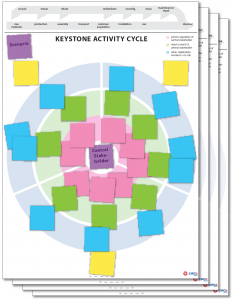About the tool
How to apply the tool?
Step 1: Add the activity scenario or variation, and the central stakeholder
The central stakeholder, in this activity cycle, is the stakeholder which is central to the scenario. This can be the end-customer, like in the Circular Value Chain Activity Cycle, but they can be other stakeholders (e.g. suppliers, dealers, service providers or other actors).
Step 2: Define PRE, DURING and POST
As the focus is now on a specific keystone activity, define what it means to prepare or get ready to perform the activity (PRE), what steps the central stakeholder takes when doing the activity (DURING), and what happens after the activity (POST).
Step 3: Add the activities
Add the activities that the central stakeholder goes through in the PRE, DURING and POST phases.
Step 4: Add the needs
Describe the needs associated with each activity, as seen from the perspective of the central stakeholder. Think of a ‘need’ as the support the stakeholder requires to complete the activity successfully.
Step 5: Add the stakeholders responsible and their roles
For each need, consider the stakeholder responsible for fulfilling it. This can be your company, another stakeholder, or a combination. Add a short description of how or in what form the need is fulfilled.
When to apply the tool?
The Keystone Activity Cycle should be used in the last phase of the process to help in establishing how the transition would happen and how to work with stakeholders.

The Keystone Activity Cycle is one of the tools presented in the CIRCit project to support various circular value chain configurations, seeking innovation through stakeholder collaboration (WB6).
Read more about the results of this focus area, explore other tools which can help in Collaborating and Networking for a Circular Economy and download the inspiring workbook here.
Downloads


